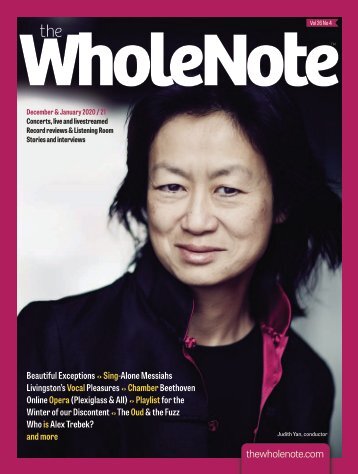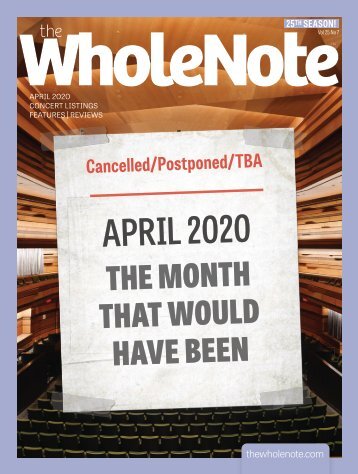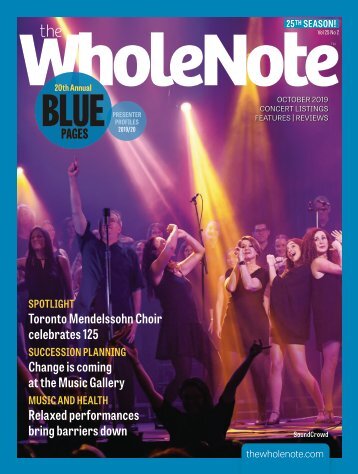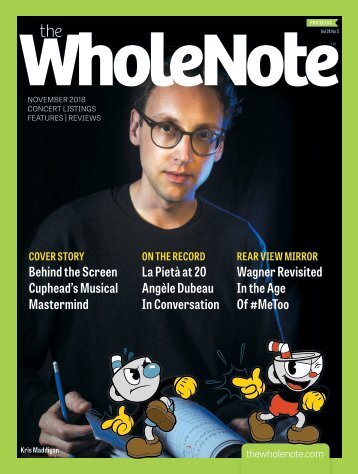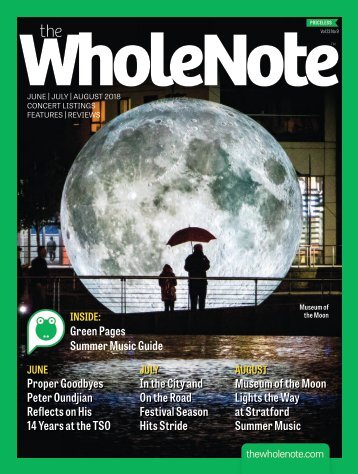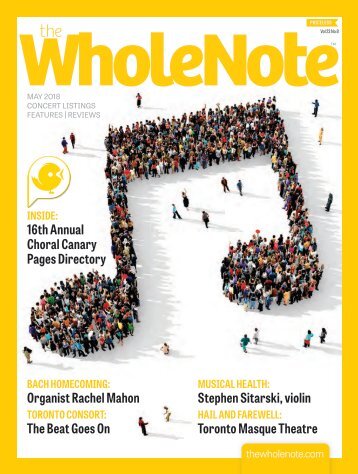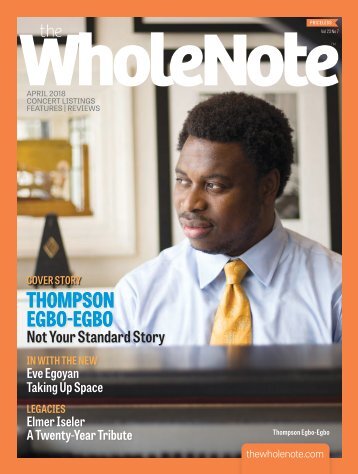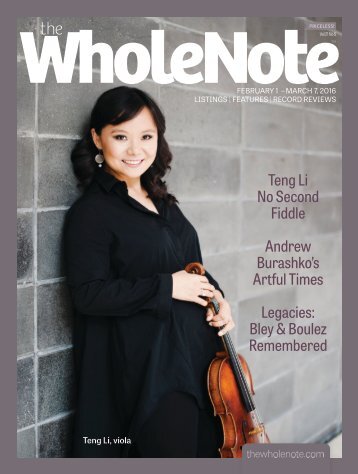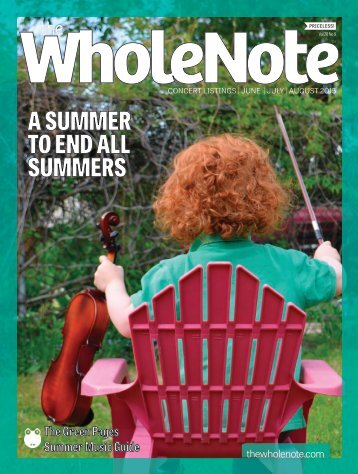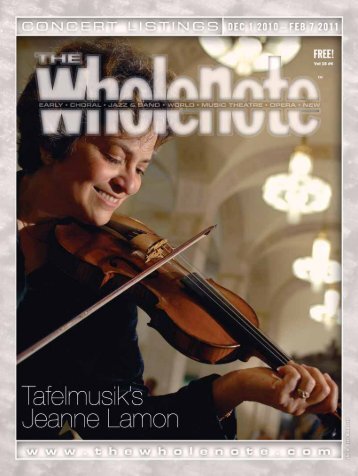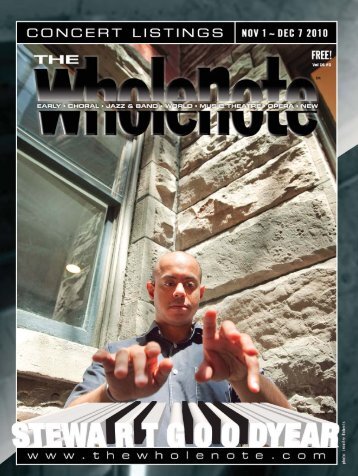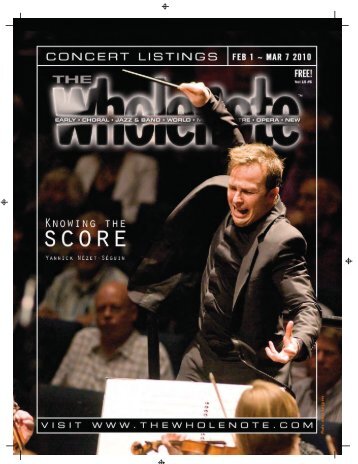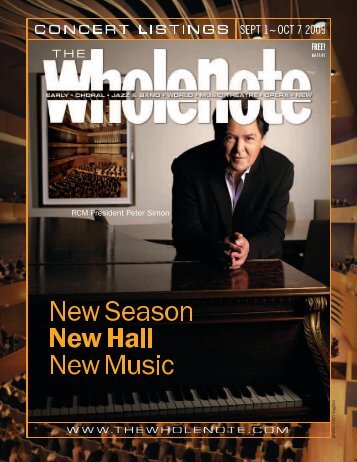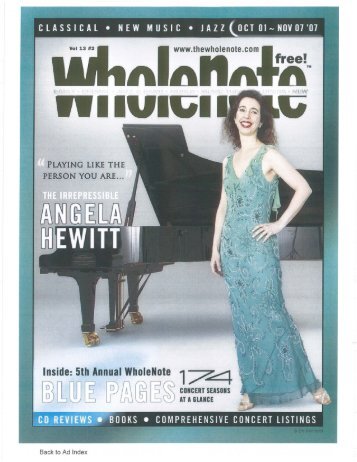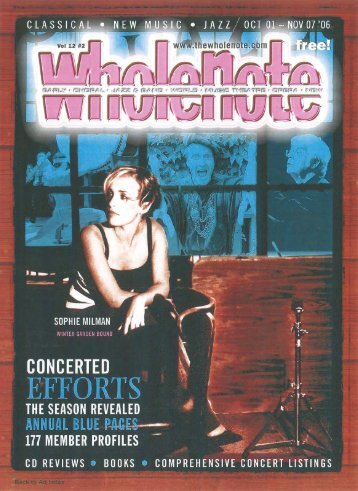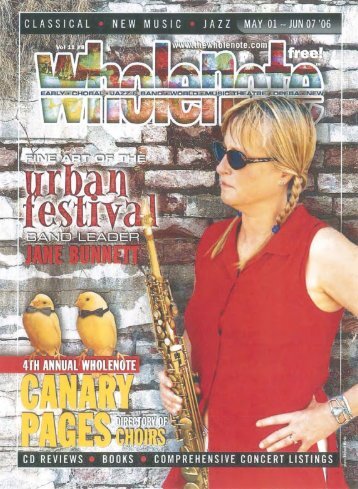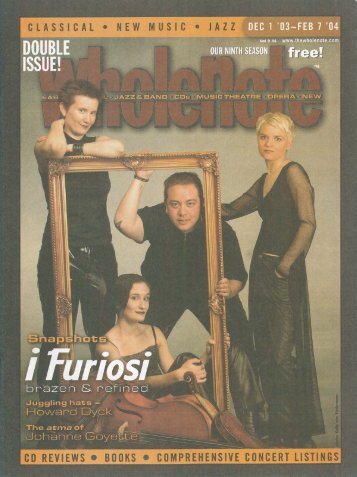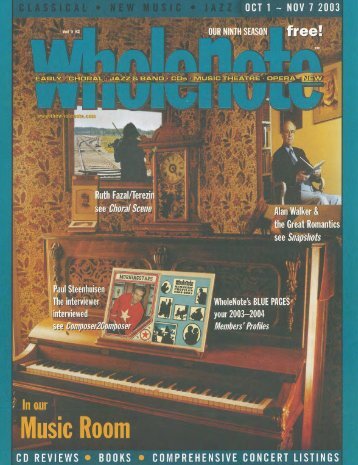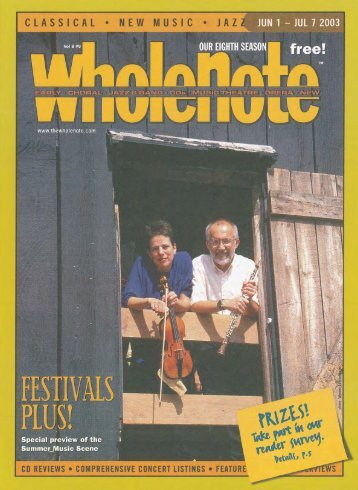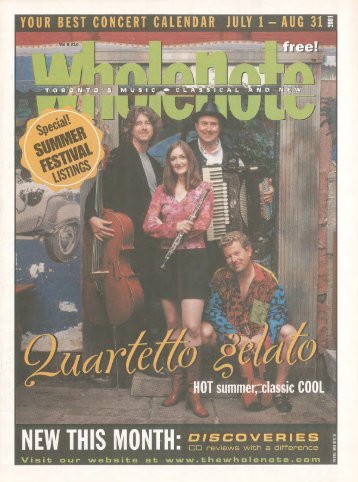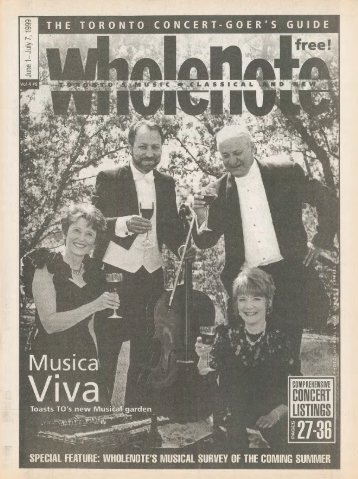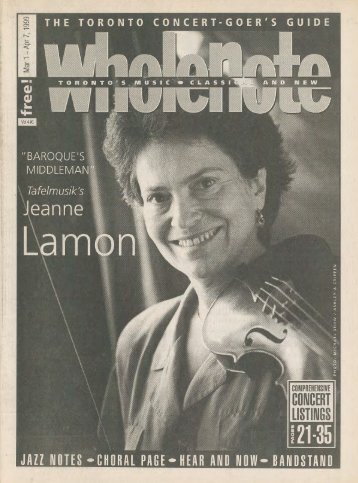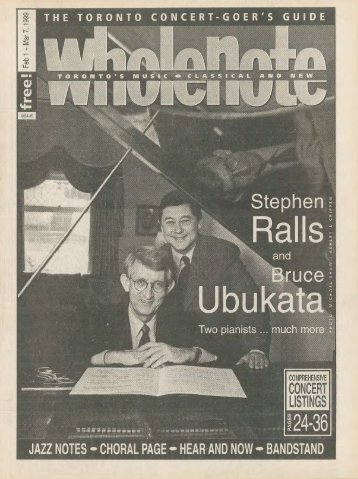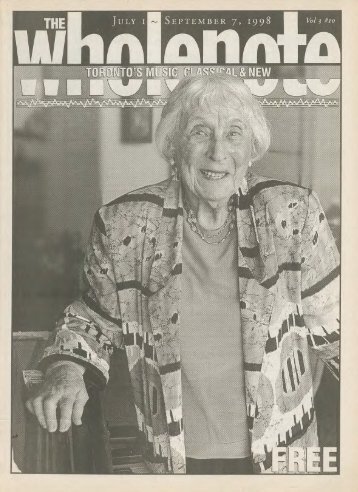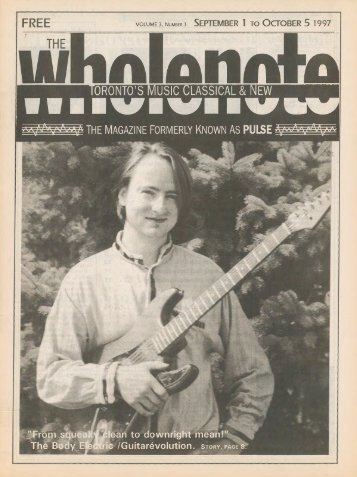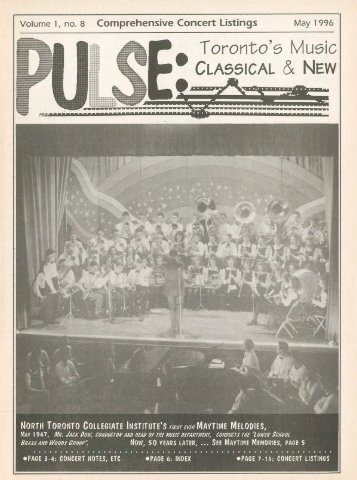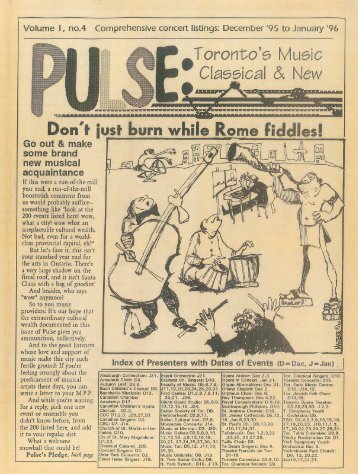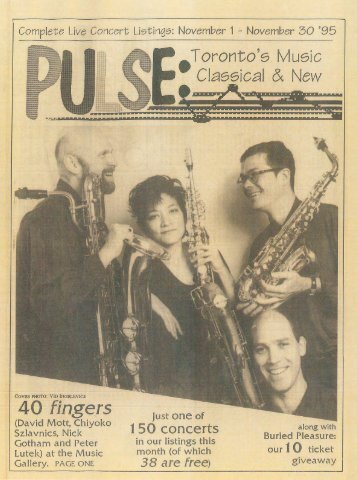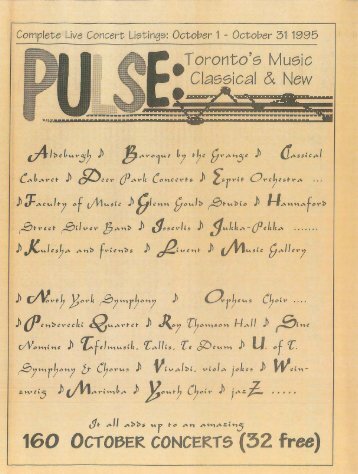Volume 25 Issue 1 - September 2019
- Text
- Theatre
- Composer
- Arts
- Quartet
- Festival
- Symphony
- Musical
- Jazz
- Toronto
- September
Vol 1 of our 25th season is now here! And speaking of 25, that's how many films in the upcoming Toronto International Film Festival editor Paul Ennis, in our Eighth Annual TIFF TIPS, has chosen to highlight for their particular musical interest.
Also inside: Rob Harris looks through the Rear View Mirror at past and present prognostications about the imminent death of classical music; Mysterious Barricades and Systemic Barriers are Lydia Perović's preoccupations in Art of Song; Andrew Timar reflects on the evolving priorities of the Polaris Prize; and elsewhere, it's chocks away as yet another season creaks or roars (depending on the beat) into motion. Welcome back.
human cry as brilliantly
human cry as brilliantly expressed by the string ensemble. Godin’s work, all that is solid melts into the air,is more ephemeral and calls for a more nuanced performance, one which Music in the Barns delivers in spades. Breathing their way into the composition that spans over 150 years of humanity, the ensemble traverses a work bookended by the visceral world of Charles Baudelaire and the beguiling symbolism of master-builder Robert Moses with transcendent splendour. The disc comes to an end with Oesterle’s Daydream Mechanics. The quintet brings a near-rhapsodic reverie inspired by the spare lyricism of Nicole Brossard’s poetry into a sensuous awakening on a disc to die for. Raul da Gama Olivier Messiaen; Linda Catlin Smith Apartment House Another Timbre at143 (anothertimbre.com) !! Toronto-based composer Linda Catlin Smith has been well represented in Another Timbre’s tenvolume release of contemporary Canadian composers, including the eight varied pieces of The Wanderer and the two-CD set, The Drifter. Here she shares a disc with that work of concentration-camp genius, Messiaen’s, Quatuor pour la fin du temps. They’re performed by the English ensemble Apartment House, and share the instrumentation of violin, cello, clarinet and piano. This is the second recording of Smith’s Among the Tarnished Stars (1998), following the Toronto ensemble The Burdocks. Apartment House stretches the piece to 28 minutes, making the most of Smith’s subtle sonic exploration, from the opening’s ascending arpeggios through an almost accordion-like blend of clarinet and strings to some wonderfully resonant ensemble clusters that ring out into the emptiness of space. The resonance and harmony make Among an ideal companion for Quatuor, a piece that transcends the grim circumstances of its composition and initial performance. Apartment House doesn’t do anything to contort the work into a post-modern aesthetic, but they do give its gestural elements new life in a rendering that never struggles to add overt emotional content to Messiaen’s materials. Clarinetist Heather Roche, however, does succeed in finding a sonority of rare resonance in the brief Intermède. Perhaps what’s most interesting about the CD is the way in which the two works live side by side, the proximity emphasizing the celestial spirit that informs Smith’s work. Stuart Broomer Spring Forward: Music for Clarinet and String Quartet David Shifrin; Miró; Dover; Jasper String Quartets Delos DE 3528 (delosmusic.com) !! Since 1981, David Shifrin, former principal clarinet of the Cleveland Orchestra, has served as artistic director of Chamber Music Northwest, the Oregon organization that commissioned these works by three well-established American composers. In Spring Forward (2014) by Peter Schickele (aka P.D.Q. Bach), Shifrin performs with the Miró Quartet. The 22-minute, fivemovement piece, typical of Schickele’s gently rocking, listener-friendly charm, evokes warm memories of springs past, including A Perfect Picnic (the last movement), fondly recalled by Schickele as one he shared with his wife at sunset by the Hudson River. Richard Danielpour’s 18-minute Clarinet Quintet (2015) is subtitled The Last Jew in Hamadan. Danielpour’s father was born in Hamadan, the Iranian city traditionally known as the burial place of the biblical Queen Esther. Danielpour writes that the first movement, Agitato, con energia, with its bouncy mix of klezmer and the Middle East, derives from vivid childhood memories of visiting Iran with his parents. The following Adagietto e triste is a meditative lament for Iran’s mostly vanished Jewish community under the ayatollahs. Shifrin is joined by the Dover Quartet, recent performers at Toronto Summer Music. Finally, Shifrin and the Jasper Quartet perform the 18-minute Perpetual Chaconne (2012) by Aaron Jay Kernis. Kernis writes that the piece “maps an emotional journey from mournful lyricism to increasingly abstract, harsh gestures and back.” It’s all rather bleak, lacking Kernis’ usual tendency to sentimentality. A bit of sentiment would have helped, much as it enhanced the pieces by Schickele and Danielpour. Michael Schulman A Tribute to Danny Granados Fidelis String Quartet and Friends; Danny Granados Delos DE 3562 (delosmusic.com) !! Member and subsequent CFO of the Houston Symphony Orchestra, Danny Granados (1964- 2018) was a brilliant clarinetist. As he writes in the liner notes, three works were recorded by him with the Fidelis String Quartet and three other musicians in 2011 after a conversation about Brahms’ beginnings, and all artists’ struggles and setbacks. After his death from cancer, the other players’ released the recording in 2019. The Fidelis String Quartet is a tight ensemble with great musicality. Granados fits in so well that his unique colourful clarinet playing never overwhelms the quartet as it blends with the strings. Brahms’ Clarinet Quintet in B Minor, Op.115 is a challenging work to play. Of note is the opening Allegro movement as Granados plays the moving clarinet melodies with luscious tones, subtle colour changes and slight rubato touches as it converses with the string lines. More clear string and poignant lowpitched clarinet conversations in the second Adagio movement. Osvaldo Golijov’s Lullaby and Doina, from the 2001 film The Man Who Cried, offers a welcome abrupt change with its plucked strings opening, quasi klezmer intense clarinet doina, higher pitched strings, flute and bass, and a fast toe-tapping closing. Piazzolla fans should enjoy the four tango selections. Highlight is pianist Pablo Zinger’s arrangement of Libertango. A piano start leads to a breathtaking legato clarinet cadenza based on its familiar tune developing into a fast instrumental rendition Timeless performances make this a moving musical memorial tribute to Danny Granados. Tiina Kiik Chesapeake – The Music of David Sampson American Brass Quintet Summit Records DCD 639 (summitrecords.com) ! ! This CD, writes American composer David Sampson (b.1951), “came from my long-held desire to write for the members of the American Brass Quintet as individuals and close friends, amplifying their unique talents and sequencing the pieces to stand as an extended composition.” What I found particularly fascinating was Sampson’s varied sonic mix of one or two brass instruments plus electronics or percussion and piano in the first four pieces, each in three or four movements. The opening, Breakaway, for two trumpets and electronics, presents echoes of Copland’s Fanfare for the Common Man and propulsive jazzy riffs that surround a darkly funereal cortege. In Powell Trio for trombone (the quintet’s Michael Powell), marimba and piano, two snappy, nervously syncopated movements, Flow and Eddies, burble around Stillwater, the quietly mysterious middle movement. Three Sides for trumpet/ flugelhorn, vibraphone and piano begins with cheery repeated staccato brass notes over a rumbling accompaniment, followed by a slow 68 | September 2019 thewholenote.com
luesy solo supported by gentle arpeggios, before ending in playful, quirky syncopations and percussive punctuations. Just Keep Moving, for horn, bass trombone, marimba and piano, is more modern-sounding, rhythmically and harmonically complex; true to its title, though, it just keeps moving. The concluding four-movement Chesapeake, for the entire quintet, depicts, writes Sampson, sailing trips with his friends down Maryland’s Chesapeake Bay. Sampson’s enjoyment of these trips is reflected in the bright, celebratory music, a fine conclusion to this fine, enjoyable disc. Michael Schulman South of the Circle Siggi String Quartet Sono Luminus DSL-92232 (sonoluminus.com) !! While it should come as no surprise that contemporary Icelandic music should have – like music elsewhere across the globe – come of age, the sheer scope and breadth of its soundscape is, nevertheless, quite breathtaking. Riding the crest of a new wave created by Björk, Atli Heimir Sveinsson and Jóhann Jóhannsson is the dazzling Siggi String quartet founded by violinist and composer Una Sveinbjarnardóttir, whose work Opacity forms one of the five pillars of the quartet’s 2019 recording South of the Circle. This follow-up to Philip Glass: Piano Works, the 2017 recording that the quartet shared with celebrated pianist and countryman Vikingur Ólafsson, is both sparkling and deeply reflective. The quartet’s interpretation of Sveinbjarnardóttir’s composition and those of three other Icelanders is marked by the poignancy of their playing. The music becomes part of a natural landscape that mixes beauty and danger. Whether evocative of freezing nights or long rainy days, each track takes us to a place – often wildly exhilarating – with trusted and inspiring musical friends. Such warmth comes at no expense to either classical elegance or avant-garde subversion. Throughout the quartet creates a compelling sound-bed for four voices of contrasting character. Although best expressed in the long inventions of the solos contained in Opacity, the virtuoso playing of the quartet is also expressed in their sculpting of the music of Daníel Bjarnason’s Stillshot, Valgeir Siguròsson’s Nebraska, Mamikó Dis Ragnarsdóttir’s Fair Flowers and Haukur Tómasson’s Serimonia. Raul da Gama Harry Partch – Sonata Dementia PARTCH Bridge Records BRIDGE 9525 (bridgerecords.com) !! Harry Partch (1901-1974) was a paradigmatic California outsider composer, embracing the pitches and rhythms of world music – Ancient Greece, Japan and Africa – and substituting a 43-tone scale in just intonation for the equal temperament of Western tradition. A romantic figure who constructed microtonal guitars as a depression-era hobo, he gained a significant audience when Columbia Records recorded him in the 1960s. His home-made instruments emphasized bending string tones and hyper resonant percussion, some made from the refuse of radiation experiments. The ensemble PARTCH is as true to the letter and spirit of Partch’s music as his own groups, and John Schneider’s intoned vocals even sound like Partch. The group has been recording landmarks and unheard works alike and supplementing them with Partch’s own archival recordings. The opening Ulysses at the Edge of the World immediately suggests the breadth of Partch’s inspirations: originally composed for jazz trumpeter Chet Baker, it combines bass marimba, tuned bamboo drums, trumpet and baritone saxophone, and ends with a joke about wanderers (i.e., Ulysses, Baker, Partch) being arrested. Twelve Intrusions (1950) is a song cycle, alive with intoned vocals, elastic pitches, and a concluding chant transcribed from a recording of the New Mexico Isleta tribe. Windsong is a collage-like film score, while Sonata Dementia includes a Scherzo Schizophrenia, indicative of Partch’s multidirectional wit. The CD concludes with Partch’s own 1942 recording of Barstow, the brilliant setting of hobo inscriptions here faster (and funnier) than the later Columbia recording. Stuart Broomer JAZZ AND IMPROVISED So Here We Are Alison Young Triplet TR10023 (alisonyoungmusic.com) !! Stellar, JUNOnominated saxophonist Alison Young has released her diverse, longawaited debut album. Those who have had the pleasure of seeing Young play live know what to expect from this record and it definitely lives up to and exceeds all expectations. There is no shortage of great musicianship on the album, featuring well-known musicians such as Eric St-Laurent on guitar, Jeff McLeod on piano and organ, Ross MacIntyre on bass, Chris Wallace on drums and Guido Basso on flugelhorn. Pieces do a great job of showcasing the talents of all musicians and are mostly written by Young herself, with the exception of three tracks. Diversity is found throughout every piece in this album. There are contrasts between elegant and energetic, driven melodies, as well as various inspirations ranging from “hard bop to soul to New Orleans-style funk.” Cedar Roots starts the record off with a righteous bang and is a strong example of the drive that drummers Chris Wallace and Sly Juhas bring to each track. Afterparty delves into a New Orleans-esque flavour with Young’s soul and funk inspirations showing through, as well as a delicious hint of traditional rock ‘n’ roll added to the mix. Celia & Harry and title track, So Here We Are, display another side of the saxophonist’s playing, leaning towards elegance, grace and a hark back to a more traditional jazz sound. Young’s album is a thoroughly enjoyable musical journey for all jazz lovers. Kati Kiilaspea Curtis Nowosad Curtis Nowosad Sessionheads United SU007 (curtisnowosad.com) ! ! Curtis Nowosad is a drummer and composer who was born and raised in Winnipeg but has lived in New York City since 2013 after moving there to complete a master’s degree at the Manhattan School of Music. This is Nowosad’s third album, the first recorded in New York, and contains five original compositions and three covers. The musicianship is impeccable with crisp horns, a tight and driving rhythm section, and arrangements reminiscent of Birth of the Cool. Highlights include Braxton Cook’s several wily alto saxophone solos and Andrew Renfroe’s guitar work on Hard Time Killing Floor Blues which is soulful, bluesy and rhythmically varied. Nowosad’s drumming is complex yet understated, always interesting but never in the way of the other player’s groove. Brianna Thomas’ assured vocals on two songs add extra nuance to the project. This album can stand alone as an excellent example of intelligent, driving jazz but there are compelling social and historical themes woven through the original compositions and cover choices. The opening Home is Where the Hatred Is comes from Gil Scott-Heron’s thewholenote.com September 2019 | 69
- Page 1 and 2:
25 th SEASON! Vol 25 No 1 SEPTEMBER
- Page 3 and 4:
2019/20 Season TAFELMUSIK MEETS TCH
- Page 5 and 6:
2501_Sept19_Cover.indd 1 2019-08-21
- Page 7 and 8:
FOR OPENERS | DAVID PERLMAN “LUDW
- Page 9 and 10:
GREAT CHAMBER MUSIC DOWNTOWN STRING
- Page 11 and 12:
Seamless Soundtracks/Notably Musica
- Page 13 and 14:
TRINA KOSTER. LYNN LANE JEAN MARTIN
- Page 15 and 16:
you were involved, as an interviewe
- Page 17 and 18: KOERNER HALL 2019.20 Concert Season
- Page 19 and 20: Application deadline September 30,
- Page 21 and 22: the most important thing in terms o
- Page 23 and 24: BO HUANG Joachim] ‘tries through
- Page 25 and 26: supportive community for contempora
- Page 27 and 28: CARLIN MA dedicated to Enescu in 19
- Page 29 and 30: CLASSICAL AND BEYOND QUICK PICKS !!
- Page 31 and 32: of his Wolastoqiyik community. His
- Page 33 and 34: A 1 25 T H ANNIVERSARY GALA CONCERT
- Page 35 and 36: funding helps with expenses, especi
- Page 37 and 38: JACK MACQUARRIE The Encore Symphoni
- Page 39 and 40: dynamics and how to develop these o
- Page 41 and 42: else. You are coming to a new level
- Page 43 and 44: offering appreciated. Thursday Sept
- Page 45 and 46: Tania Miller conducts the Royal Con
- Page 47 and 48: concert date. ●●2:00: Fall for
- Page 49 and 50: Liadov: The Enchanted Lake; Stravin
- Page 51 and 52: a year of new artistic leadership f
- Page 53 and 54: Room ED2008 (violin), Taylor Centre
- Page 55 and 56: Barricades and Barriers continued f
- Page 57 and 58: DISCOVERIES | RECORDINGS REVIEWED D
- Page 59 and 60: Artists (ICAC 5156 naxos.com). It f
- Page 61 and 62: Keyed In Beethoven & Liszt Piano Co
- Page 63 and 64: principals, together, then express
- Page 65 and 66: Antonin Dvořák - Piano Quartets N
- Page 67: MODERN AND CONTEMPORARY André Math
- Page 71 and 72: total delight. McGuiness scats over
- Page 73 and 74: player’s body, and a small rattle
- Page 75 and 76: conducted by Carlo Maria Giulini wi
- Page 78 and 79: Music in Film: 8th Annual TIFF TIPS
- Page 80: Season Sponsor Alex Pauk, Founding
Inappropriate
Loading...
Mail this publication
Loading...
Embed
Loading...
























